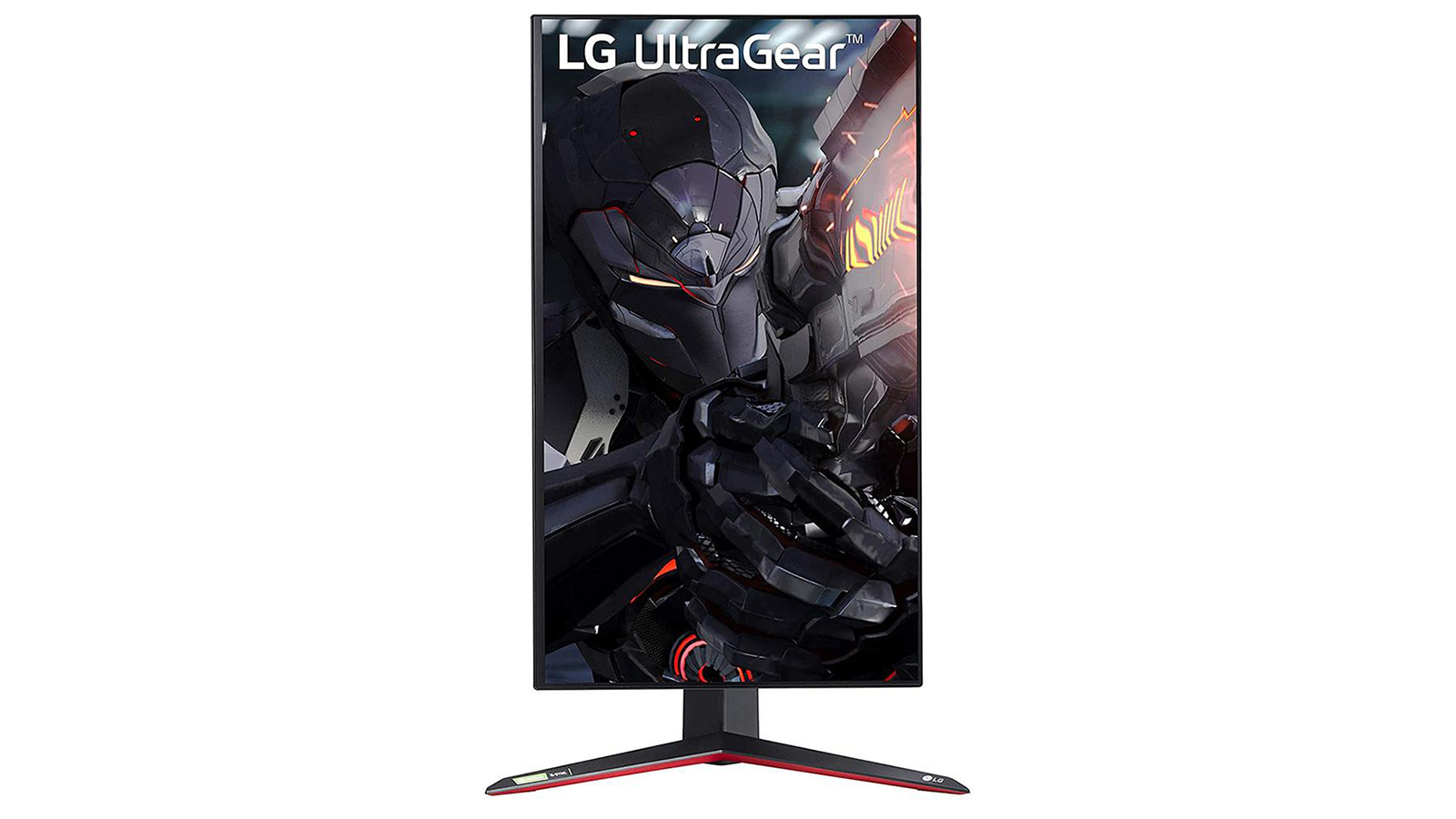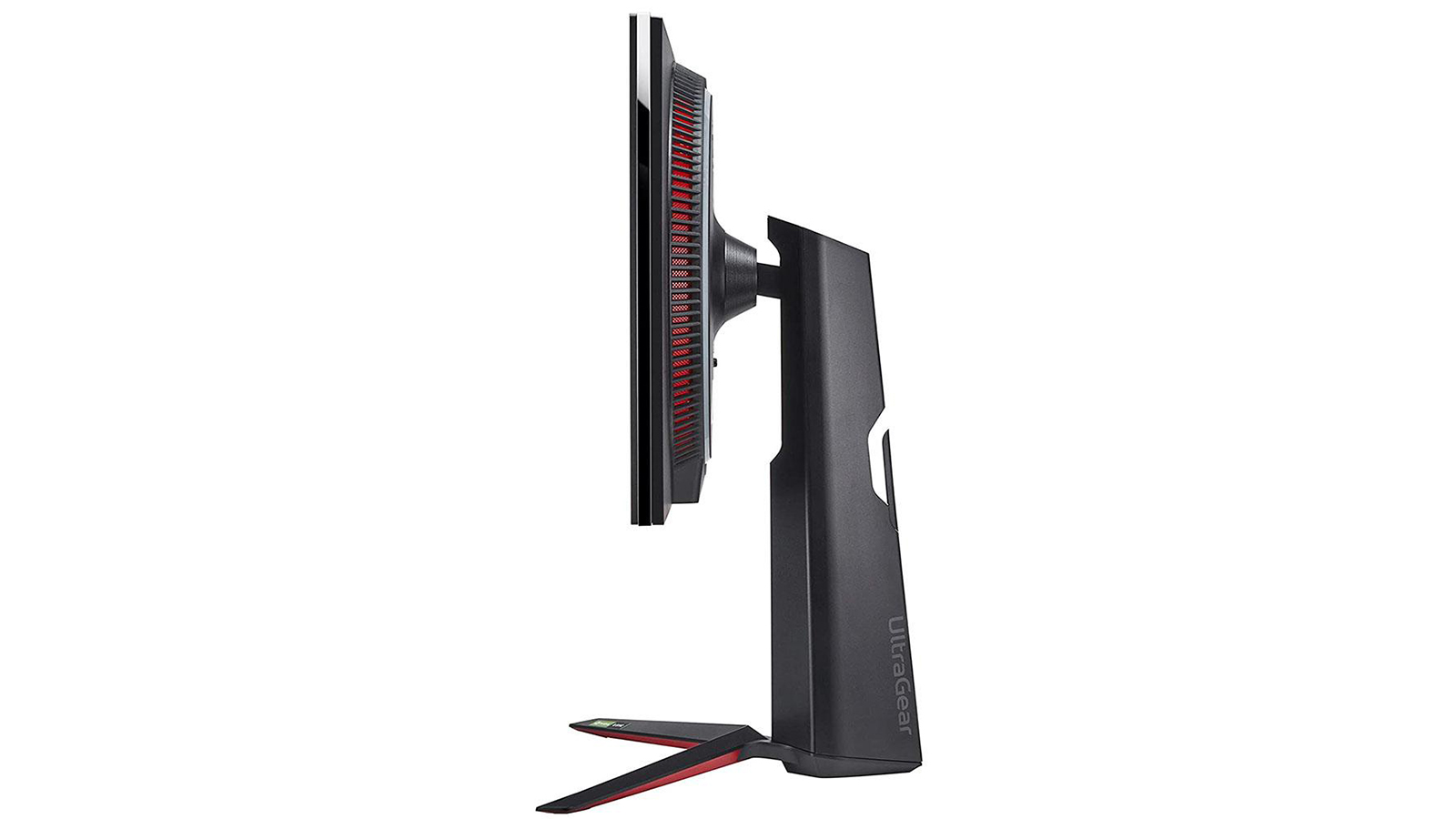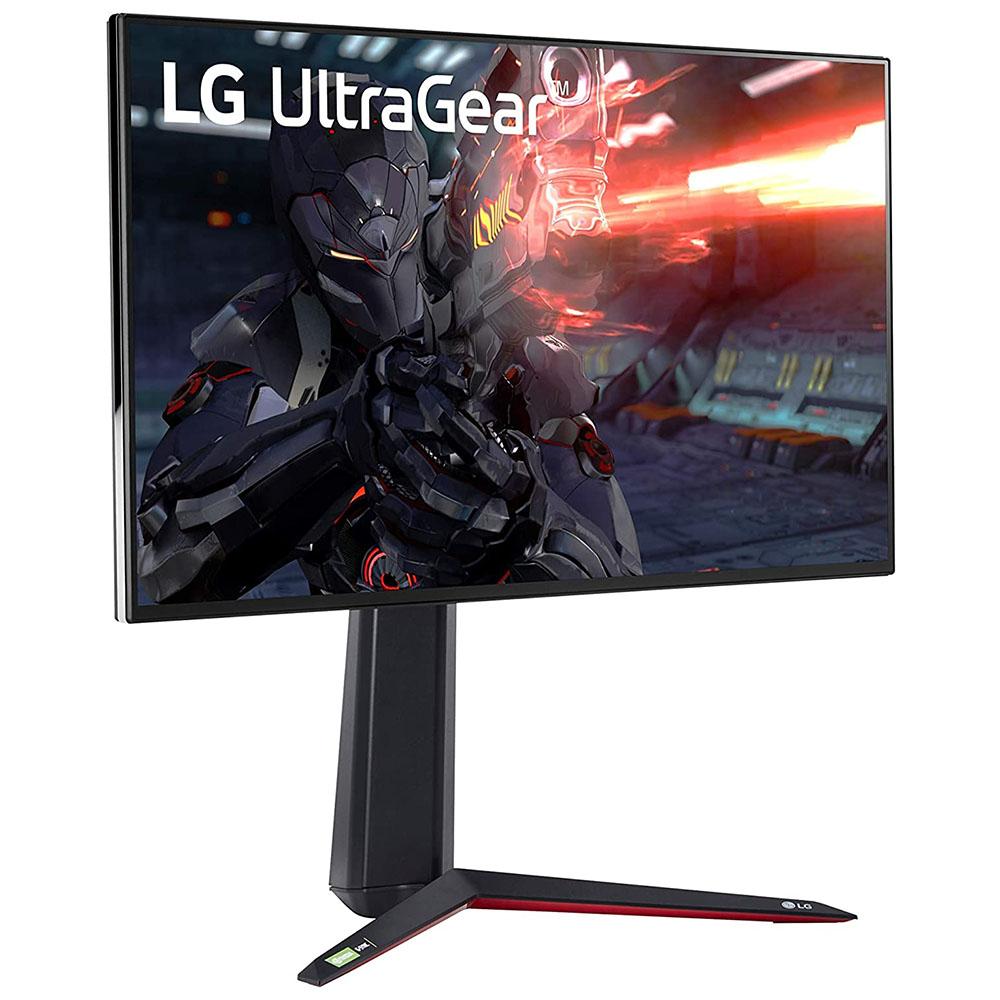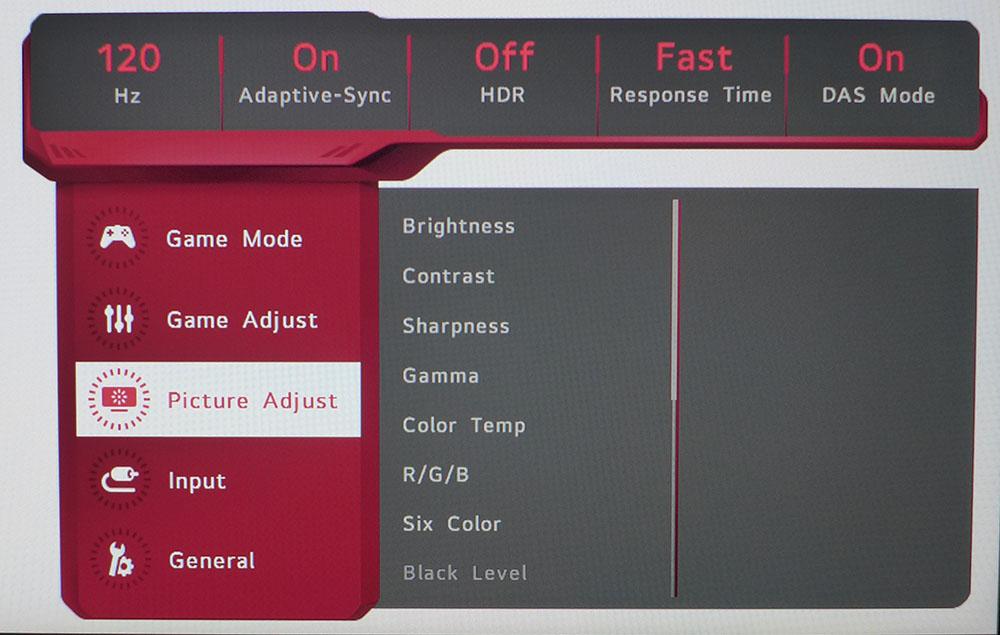Tom's Hardware Verdict
One of the fastest 4K monitors at 144 Hz, the LG 27GN950-B delivers accurate color and excellent HDR for cheaper than a top-of-the-line FALD display.
Pros
- +
Ultra HD resolution
- +
Local dimming produces VA-like contrast
- +
Excellent HDR
- +
Wide and accurate color gamut
- +
Fast and responsive
- +
FreeSync & G-Sync Compatible
Cons
- -
Oversaturated sRGB mode
Why you can trust Tom's Hardware
The pinnacle of desktop PC monitor resolution is 4K (3840 x 2160 pixels), at least for now and the foreseeable future. Even at 32 inches diagonal, screen density is enough to hide any trace of the image’s pixel structure. A 27-inch 4K monitor sports a highly-packed 163 pixels per inch, and that means you can sit super close and never see the dots.
What does this mean for those seeking the best gaming monitor? High resolution is great but has a significant impact on frame rates. It takes one of the top cards on our GPU benchmarks hierarchy to drive 8.3 million pixels faster than 100 frames per second (fps). That fact, and the high price of speedy 4K monitors has made this a small and exclusive club.
LG adds to this short list of choices with the LG 27GN950-B ($800 as of writing). It combines a 144 Hz refresh rate with AMD FreeSync Premium Pro and G-Sync Compatibility, DisplayHDR 600 and a wide color gamut. Is it a worthy competitor to leaders on our Best 4K Gaming Monitors and Best Computer Monitors lists? Can it take on the standard-bearing Acer Predator X27 and Asus ROG Swift PG27UQ? Let’s take a look.
LG 27GN950-B Specifications
| Panel Type & Backlight | IPS / W-LED, edge array |
| Screen Size & Aspect Ratio | 27 inches / 16:9 |
| Max Resolution & Refresh | 3840 x 2160 @ 144 Hz |
| Row 3 - Cell 0 | AMD FreeSync Premium Pro: 48-144 Hz |
| Row 4 - Cell 0 | G-Sync Compatible |
| Native Color Depth & Gamut | 10-bit (8-bit+FRC) / P3 |
| Row 6 - Cell 0 | HDR10, DisplayHDR 600 |
| Response Time (GTG) | 1ms |
| Brightness (mfr) | 400 nits SDR |
| Row 9 - Cell 0 | 600 nits HDR |
| Contrast (mfr) | 1,000:1 |
| Speakers | None |
| Video Inputs | 1x DisplayPort 1.4 (DSC) |
| Row 13 - Cell 0 | 2x HDMI 2.0 |
| Audio | 3.5mm headphone output |
| USB 3.0 | 1x up, 2x down |
| Power Consumption | 30.4w, brightness @ 200 nits |
| Panel Dimensions WxHxD w/base | 23.9 x 18.1-22.5 x 11.5 inches (607 x 460-572 x 292mm) |
| Panel Thickness | 2.1 inches (53mm) |
| Bezel Width | Top/sides: 0.2 inch (5mm) |
| Row 20 - Cell 0 | Bottom: 0.4 inch (10mm) |
| Weight | 16.9 pounds (7.7kg) |
| Warranty | 3 years |
The 27GN950-B’s price of entry is the first thing we noticed. At this writing, LG is selling it for $800. That undercuts the aforementioned Asus and Acer monitors significantly. The principal reason for this is its backlight. Rather than the full-array local-dimming (FALD) units used by Asus and Acer, LG employs an edge-lit backlight but offers a local dimming feature of its own. By selectively dimming the individual LEDs, it achieves HDR quality that comes close to its FALD cousins.
The panel is dubbed "Nano IPS" and that refers to the IPS panel's sub-pixel structure. Its goal is to widen the color gamut, much like the Quantum Dot technology used by Samsung and others. LG achieves that goal with a measured 95% coverage of the DCI-P3 color space. The backlight also delivers over 600 nits in HDR mode, enough to earn a VESA DisplayHDR 600 certification (see our article on how to choose the best HDR monitor).
The big story here is the 27GN950-B’s refresh rate. 144 Hz 4K monitors are rare and have serious bandwidth requirements. To run at full honk, you’ll need a graphics card (likely one of the best graphics cards) with DisplayPort 1.4 capability because LG uses Display Stream Compression to get all those pixels over a single cable. Definitely check your graphics card specs before pulling the trigger on this monitor.
If you have the hardware, the 27GN950-Bcan deliver 144 Hz with HDR and FreeSync Premium Pro over DisplayPort. That means it includes Low Framerate Compensation for speeds below 48 Hz. It also carries G-Sync Compatibility certification from Nvidia with the same capabilities.
Get Tom's Hardware's best news and in-depth reviews, straight to your inbox.
Assembly and Accessories for LG 27GN950-B
After mating the base and upright with two captive bolts, the 27GN950-B’s panel snaps in place. You’ll find a tiny clip in the box for cable management, along with wires for DisplayPort, HDMI and USB. The power supply is an external brick. Given the monitor’s bandwidth requirements, LG recommends using the supplied cables to run 4K resolution at 144 Hz.
LG 27GN950-B Product 360





The LG 27GN950-B has the thinnest bezel we’ve seen to date, just 5mm at the top and sides and 10mm on the bottom. While not truly frameless, it’s closer to that goal than any other monitor we know of.
Styling is angular with corners rounded just enough to not be sharp. Finishes are the usual matte black in brushed and pebble styles. The base features red trim on the bottom with LG and G-Sync logos in proud view.
In back, is a swoopy version of the LG logo, along with a ring of RGB LEDs around the upright’s attachment point. You can remove the stand to use the 100mm VESA mount and still enjoy the lights. You control the RGB with a dial on the bottom-center. Pressing it turns them on. Then, you can change the effect by scrolling through six options. You can also coordinate the effects with sound and on-screen content by using LG’s downloadable Ultragear Control Center app.
The stand offers a 4.4-inch height adjustment with 5/15 degree tilt and a portrait mode. There is no swivel function. Movements are very solid and feel like a premium monitor should.
LG’s trademark rear-facing input panel makes it super easy to see what you’re plugging in. There are two HDMI 2.0 ports and one DisplayPort 1.4 (see DisplayPort vs HDMI: which is better for gaming?). Also included is USB 3.0, one upstream and two down. A 3.5mm audio jack supports headphones or powered speakers. There are no speakers built into the 27GN950-B.
OSD Features of LG 27GN950-B
The 27GN950-B’s OSD and power are controlled by a tiny joystick found in the bottom center of the panel. You can click it to the sides for volume control and fore/aft to adjust brightness. Press it, and you get a quick menu with input selection, game mode, power and the full menu.
Game Mode refers to the monitor’s picture eight presets. Gamer 1 is the default and accurate enough to be used without calibration if the P3 gamut is your goal. sRGB is included but only shrinks the gamut slightly with over 130% coverage. If you’d like to apply the look of HDR to SDR content, HDR Effect can do this. It preserves highlight and shadow detail well, but its look is a matter of personal preference. You also get two Calibration modes, which require LG’s True Color Pro software to unlock.
Game Adjust has an Adaptive-Sync toggle, Black Stabilizer for brighter shadows, three-level overdrive (Fast is the best setting) and a selection of aiming points.
In the Gamer 1 preset, all the LG 27GN950-B’s calibration controls are available. There are four gamma presets, three color temps, plus a custom mode, a method of selection by Kelvin value and a six-color hue and saturation menu. All adjustments are precise with fine resolution and excellent accuracy. Minor changes will produce a very accurate monitor.
Though it has an edge backlight, the LG 27GN950-B features local dimming. It has a small impact on SDR quality but a big one in HDR mode, offering deep contrast, true blacks bright highlights and, therefore, some of the best HDR performance we've seen among mainstream monitors.
LG 27GN950-B Calibration Settings
The 27GN950-B doesn’t require calibration, but there are small gains available with a few tweaks. The best gamma preset is Mode 4, and that requires a single click of the red slider to bring grayscale tracking to an error-free state.
Color is always in the P3 gamut, regardless of picture mode. Selecting sRGB reduces saturation a little but not enough to qualify as a true sRGB monitor. We also lowered Contrast a little to improve gamma and fix a red clipping issue at 100% brightness. Note that any change to gamma requires recalibration of the white point.
Here are the settings we used for SDR content: HDR locks out all image controls except brightness.
| Picture Mode | Gamer 1 |
| Brightness 200 nits | 26 |
| Brightness 120 nits | 7 |
| Brightness 100 nits | 3 (min. 89 nits) |
| Contrast | 68 |
| Gamma | Mode 4 |
| Color Temp Custom | Red 51, Green 50, Blue 50 |
HDR locks out all image controls except brightness.
Gaming and Hands-on with the LG 27GN950-B
The 27GN950-B offers a few different dynamic contrast options. You can just use it as it comes from the box in Gamer 1 mode with Local Dimming turned off, which looks quite good. The monitor has similar contrast to other IPS monitors but a bit more color saturation, thanks to its wide P3 gamut coverage. With the backlight set for 200 nits brightness, we could work all day without fatigue on documents and graphic editing.
With Local Dimming on, contrast doubled, and it shows. Color looked more vivid, with blacks appearing deeper. Highlight and shadow detail was also typically preserved without clipping. A few times, we saw it working when a small bright object appeared against a black background. Then, it was possible to see a vertical band where the backlight was stronger than the surrounding area. It’s like the halo effect sometimes seen in FALD displays but the halo extends the full height of the screen. This was a rare occurrence.
This is one of the very few monitors that looks good running Windows productivity apps in HDR mode. Color is a little hazy, but contrast is very good. And if it looks too harsh, you can turn down the brightness. The LG 27GN950-B is one of the few monitors we’ve seen that lets you dial down the light level in HDR mode. An alternative to this is the HDR Effect mode. It’s searingly bright at its default brightness setting of 100. But turn the backlight down to 26 (around 200 nits) and it’s more palatable. Users have several good, useful options here.
SDR gaming was much the same experience. Tomb Raider always looks great when there's extra color available. The LG 27GN950-B has plenty to offer. We stuck with the Gamer 1 mode and Local Dimming turned on. Contrast was superb, and color was extremely enjoyable. Motion processing was flawless as we played at around 110 fps.
The GeForce GTX 1080 Ti in our test system can't do 4K at 144 Hz because it lacks DisplayPort 1.4. But the LG 27GN950-B ran fine at 120 Hz, and we never hit 120 fps in the game with details maxed. When we played with a Radeon RX 5700 XT, the full 144 Hz became available as this card supports DisplayPort 1.4 and Display Stream Compression. In both cases though, Adaptive-Sync worked perfectly.
Turning to Call of Duty: WWII and its HDR capability, we enjoyed the effect immensely. Highlights popped brightly while shadows looked dark and detailed. If you’re shopping for an HDR monitor, the 27GN950-B is a great alternative to a more expensive FALD display. We played with HDR and 144 Hz on our RX 5700 XT-based system, though in-game speeds never exceeded 110 fps. The same was true of the GTX 1080 Ti platform. You’ll need a stout graphics board (or two) to hit 144 Hz at 4K.

Christian Eberle is a Contributing Editor for Tom's Hardware US. He's a veteran reviewer of A/V equipment, specializing in monitors. Christian began his obsession with tech when he built his first PC in 1991, a 286 running DOS 3.0 at a blazing 12MHz. In 2006, he undertook training from the Imaging Science Foundation in video calibration and testing and thus started a passion for precise imaging that persists to this day. He is also a professional musician with a degree from the New England Conservatory as a classical bassoonist which he used to good effect as a performer with the West Point Army Band from 1987 to 2013. He enjoys watching movies and listening to high-end audio in his custom-built home theater and can be seen riding trails near his home on a race-ready ICE VTX recumbent trike. Christian enjoys the endless summer in Florida where he lives with his wife and Chihuahua and plays with orchestras around the state.
-
CXB The most recent firmware to the LG 27GN950-B pushes the display rate to 160Hz at 4k (the firmware takes a nervous 30+ minutes to load)Reply
A very nice monitor, well-suited to DisplayPort, DSC and the new graphics cards coming out (I was lucky to bag an RTX3070) -
Wanderingm00se Honestly, if this had an HDMI 2.1 it would have been an instant buy for me running this well. Maybe a refresh next year will have it. Got a series X as video card prices in Canada are insane right now if available and consoles are almost readily available and are cheaper than US pricing after conversion.Reply -
tomy_12 I heard with this monitor cannot cancel the option that the monitor will go to deep sleep, is kind of big let down when the monitor fall a sleep and can't wake up. I don't want my monitor to fall a sleep, I can make the pc set to sleep mode alone. would be nice if you can mention it in the review.Reply -
CXB Well, you may have heard that, but I've just left my PC and my LG 27GN950 alone for 4 hours, and as soon as I hit my space bar on the keyboard, everything just woke up where it had left off.Reply
What I do find is that sometimes, with a second monitor, the GPU gets in a twist. But that's not a problem related to this monitor.




